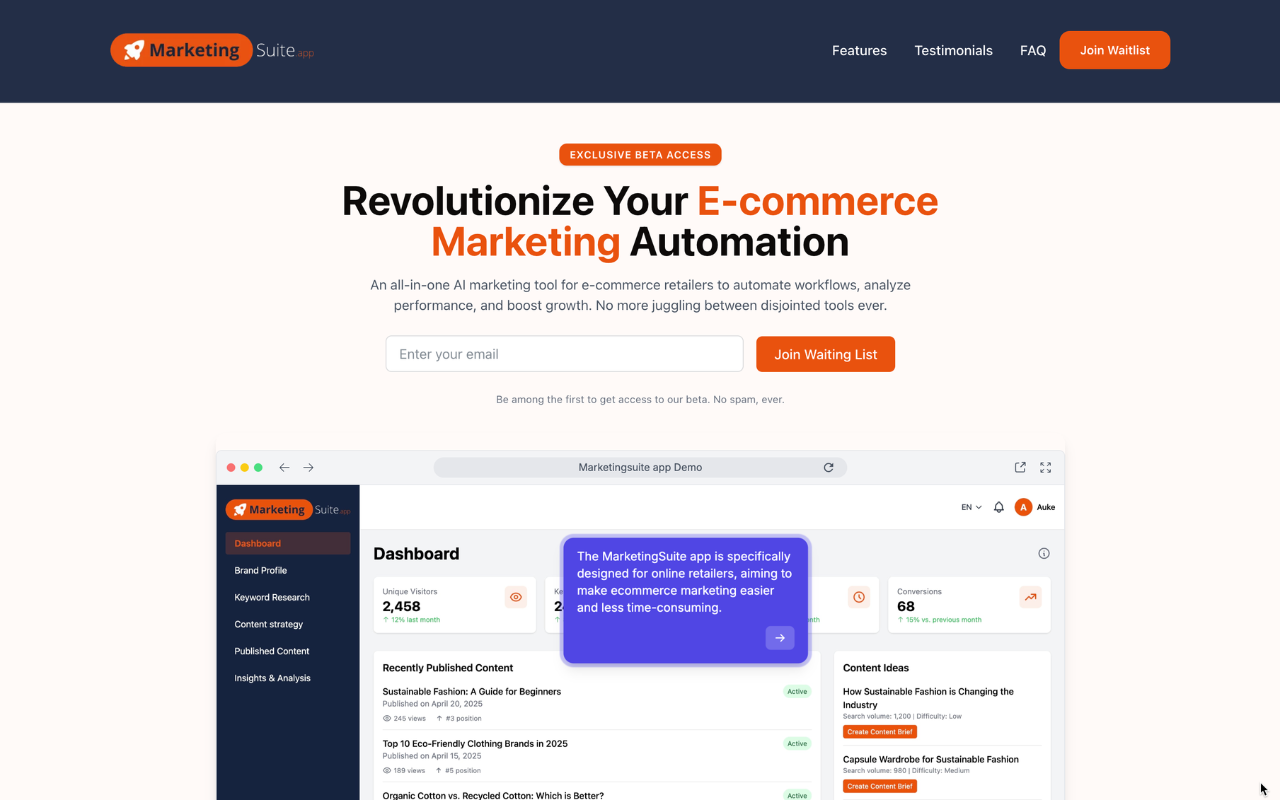Building a successful e-commerce brand involves much more than just having the right products. Studies reveal that brands with a defined content workflow experience significantly higher engagement and conversion rates. Most people believe content is just about writing catchy product descriptions or posting on social media, but that barely scratches the surface. The real secret lies in a detailed, step-by-step content strategy that connects every piece to broader business goals and adapts faster than any competitor.
Quick Summary
| Key Point | Explanation |
|---|---|
| 1. Conduct a content audit | Map current content to identify gaps and strengths for improvement. |
| 2. Create a detailed content plan | Develop a content calendar that outlines creation, publication, and goals for each piece. |
| 3. Optimize content for engagement | Craft high-quality, audience-focused content that solves problems and resonates emotionally. |
| 4. Use analytics for performance measurement | Track engagement metrics to assess content effectiveness and inform strategy adjustments. |
| 5. Foster a dynamic content strategy | Regularly review and refine content based on performance insights and market trends. |
Step 1: Analyze Your Content Requirements
Creating a successful step-by-step content workflow for e-commerce begins with a comprehensive content requirements analysis. This critical first phase sets the foundation for your entire content strategy, ensuring you develop targeted, purposeful content that resonates with your specific audience and business objectives.
Start by conducting a thorough audit of your current content landscape. Map out existing product descriptions, blog posts, social media content, and customer communication channels. Your goal is to identify content gaps, strengths, and opportunities for strategic improvement. Examine which content types generate the most engagement, drive conversions, and align with your brand’s unique value proposition.
Determine your specific content needs by segmenting your analysis across several key dimensions. Consider your product range, target customer personas, sales funnel stages, and marketing objectives. Each product category might require a different content approach—for instance, technical products demand more detailed, specification-heavy descriptions, while lifestyle products benefit from aspirational, storytelling narratives.
Use data-driven insights to refine your content requirements. Research from Content Marketing Institute shows that successful e-commerce brands leverage detailed customer data to personalize content strategies. Analyze metrics like customer demographics, browsing behaviors, purchase histories, and interaction patterns to understand precisely what content will motivate your audience.
Establish clear content parameters that will guide your workflow. Define essential elements such as tone of voice, brand messaging guidelines, required content types (product descriptions, buying guides, customer testimonials), and desired content outcomes. Create a comprehensive content brief that serves as a north star for all future content creation efforts.
Finally, validate your content requirements by cross-referencing them with your broader business strategy. Ensure that each content piece supports specific marketing goals—whether that’s increasing average order value, improving customer retention, or expanding into new market segments. A well-analyzed content requirement framework transforms random content creation into a strategic, purposeful engine of e-commerce growth.
Below is an overview table summarizing each key step in the e-commerce content workflow, along with its primary focus and the main goal for that stage.
| Step | Focus Area | Primary Goal |
| 1. Analyze Content Requirements | Content audit, gap analysis, define parameters | Identify needs and align content with business objectives |
| 2. Develop Content Plan | Content calendar, channel selection, diversification | Strategically organize creation and rollout |
| 3. Create and Optimize Content | Storytelling, SEO, brand voice | Engage audience, build trust, and drive conversion |
| 4. Schedule and Publish Content | Centralized management, multi-channel execution | Ensure timely and consistent delivery |
| 5. Monitor and Measure Performance | Analytics tracking, reporting, iteration | Optimize based on actionable data |
| 6. Refine Content Strategy | Auditing, cross-functional review, experimentation | Continuously improve and innovate strategies |
![]()
Step 2: Develop a Content Plan
Transforming your content requirements into a strategic roadmap requires meticulous planning and precise execution. A robust content plan serves as your navigation system, guiding every piece of content from conception to publication while ensuring consistency and maximum impact across your e-commerce ecosystem.
Begin by creating a comprehensive content calendar that maps out your entire content strategy. This calendar will be your strategic blueprint, detailing exactly what content will be created, when it will be published, and which channels it will target. Break down your content plan by product categories, marketing objectives, and customer journey stages. Each content piece should have a clear purpose—whether that’s generating awareness, driving consideration, or facilitating conversion.
Research from Content Marketing Institute reveals that successful e-commerce brands develop content plans that integrate seamlessly across multiple platforms. Your plan should outline specific content types for each channel: detailed product descriptions for your website, engaging social media posts, informative blog articles, email marketing sequences, and customer education resources.
Prioritize content diversification to maintain audience engagement. Mix different content formats such as how-to guides, customer testimonials, behind-the-scenes stories, product comparison articles, and user-generated content. This approach prevents content fatigue and provides multiple touchpoints for potential customers to connect with your brand. Consider the unique strengths of each content type and how they can work together to create a cohesive narrative that guides customers through their purchasing journey.
Establish clear workflows and assign specific responsibilities within your content creation process. Determine who will be responsible for research, writing, editing, graphics, and final approvals. Create detailed content briefs for each piece that include target audience, key messaging, desired outcomes, and specific guidelines to maintain brand consistency.
Finally, build flexibility into your content plan. While structure is crucial, your strategy must remain adaptable to market changes, emerging trends, and real-time customer feedback. Schedule regular review periods—perhaps quarterly—to assess content performance, identify areas for improvement, and realign your approach with evolving business goals. A dynamic content plan is not a static document but a living strategy that continuously evolves to drive your e-commerce success.
Use this checklist table to verify that all essential elements of your e-commerce content plan are being addressed during planning and regular reviews.
| Checklist Item | Description | Completion Status |
|---|---|---|
| Content Calendar Prepared | Plan for all platforms, channels, and timings | To Do / In Progress / Done |
| Content Formats Diversified | Mix of blogs, guides, testimonials, social posts | To Do / In Progress / Done |
| Roles and Tasks Assigned | Define team responsibilities for each stage | To Do / In Progress / Done |
| Brand Voice Guidelines Documented | Rules for tone, language, and messaging consistency | To Do / In Progress / Done |
| Review Periods Scheduled | Regular performance checks and updates planned | To Do / In Progress / Done |
| Flexibility Built Into Plan | Ability to adjust for trends and market shifts | To Do / In Progress / Done |
Step 3: Create and Optimize Content
Content creation represents the critical transformation point where strategic planning converts into tangible marketing assets that drive e-commerce engagement. Your content must not only inform but also inspire and motivate potential customers to take action, seamlessly bridging the gap between interest and purchase.
High-quality content begins with understanding your audience’s deepest needs and pain points. Craft each piece of content as a solution-oriented narrative that speaks directly to specific customer challenges. For product descriptions, move beyond basic specifications by weaving compelling stories that highlight how your products solve real-world problems. Use language that resonates with your target demographic, blending technical accuracy with emotional appeal.
Research from Stanford Graduate School of Business emphasizes the importance of creating content that feels authentic and valuable. Integrate customer testimonials, user-generated content, and real-world application scenarios to build trust and credibility. Each content piece should answer the fundamental customer question: “What’s in it for me?”
Optimization is not an afterthought but an integral part of content creation. Implement search engine optimization strategies from the beginning, incorporating relevant keywords naturally within your content. Focus on creating comprehensive, long-form content that provides genuine value while strategically addressing search intent. This approach not only improves search rankings but also establishes your brand as an authoritative resource in your industry.
Develop a consistent brand voice that remains uniform across all content types. Whether you’re writing product descriptions, blog posts, or social media captions, maintain a tone that reflects your brand’s personality and resonates with your target audience. This consistency builds brand recognition and helps customers form a stronger emotional connection with your e-commerce platform.
Finally, embrace a data-driven approach to content optimization. Regularly analyze performance metrics such as engagement rates, conversion rates, and customer feedback. Use these insights to continuously refine your content strategy, testing different approaches and being willing to pivot when certain content types or styles are not delivering the desired results. Remember, content creation is an ongoing process of learning, adapting, and improving to meet the ever-changing needs of your e-commerce ecosystem.
Step 4: Schedule and Publish Content
Scheduling and publishing content represents the strategic execution of your carefully crafted content workflow. This critical phase transforms your content plan from a theoretical blueprint into a dynamic, live marketing strategy that engages potential customers across multiple platforms.
Develop a centralized content management system that coordinates publishing across all your digital channels. Choose a robust platform that allows seamless scheduling, real-time collaboration, and comprehensive content tracking. Consider tools that integrate multiple functions, enabling you to schedule blog posts, social media updates, email newsletters, and product announcements from a single dashboard. This approach eliminates fragmentation and ensures consistent messaging across your e-commerce ecosystem.
Research from Digital Workflow Management highlights the importance of strategic timing in content publishing. Analyze your audience’s online behavior to determine optimal posting times for maximum engagement. Different platforms have unique peak activity periods—what works on Instagram might not be ideal for LinkedIn. Develop a nuanced publishing strategy that considers time zones, audience demographics, and platform-specific algorithms.
Implement a multi-channel publishing approach that creates a cohesive narrative across all platforms. Each piece of content should be slightly adapted to suit the specific platform while maintaining a consistent core message. A blog post might become a series of social media graphics, an email newsletter highlight, or a bite-sized video snippet. This cross-platform strategy amplifies your content’s reach and reinforces your brand’s messaging.
Establish a reliable content approval workflow that ensures quality and brand consistency before publication. Create a clear chain of review that involves content creators, subject matter experts, and brand managers. Set up automated notifications and clear deadlines to prevent bottlenecks and maintain your publishing schedule. Implement version control mechanisms that track content revisions and provide transparent accountability.
Finally, build flexibility into your publishing strategy. While consistency is crucial, be prepared to adjust your schedule in response to real-time events, emerging trends, or unexpected market shifts. Maintain a buffer of evergreen content that can be deployed quickly if your primary content needs to be modified. Regular performance reviews will help you continuously refine your scheduling approach, ensuring your content remains dynamic, relevant, and effective in driving e-commerce growth.
Step 5: Monitor and Measure Performance
Measuring content performance transforms raw data into actionable insights that drive continuous improvement in your e-commerce content workflow. This critical step goes beyond surface-level metrics, providing a comprehensive understanding of how your content impacts business objectives and customer engagement.
Establish a robust analytics framework that tracks both quantitative and qualitative performance indicators. Implement advanced tracking tools that provide granular insights into content performance across multiple dimensions. Focus on key metrics such as engagement rates, conversion rates, time on page, bounce rates, and revenue generated directly from content interactions. These metrics will reveal not just how many people view your content, but how effectively it drives meaningful business outcomes.
Research from Harvard Business School emphasizes the importance of developing a nuanced approach to performance measurement. Create a comprehensive dashboard that integrates data from multiple sources, website analytics, social media platforms, email marketing tools, and sales systems. This holistic view allows you to understand the interconnected impact of your content strategy across different marketing channels.
Develop a systematic approach to performance analysis that goes beyond monthly reporting. Schedule weekly content performance reviews that allow for rapid iteration and optimization. Identify top-performing content pieces and analyze the specific elements that contribute to their success. Equally important, examine underperforming content to understand potential barriers or misalignments with your target audience’s expectations.
Implement a continuous improvement cycle that transforms performance insights into actionable strategy modifications. Create a feedback loop where performance data directly informs your content creation process. This might involve adjusting content types, refining messaging, exploring new content formats, or realigning your targeting strategy. Be prepared to experiment and pivot quickly based on the insights you uncover.
Finally, establish a comprehensive reporting system that communicates content performance to key stakeholders. Develop clear, visually compelling reports that translate complex data into actionable insights.
These reports should not just showcase metrics but tell a compelling story about how your content strategy drives business growth. By maintaining transparency and demonstrating the tangible value of your content workflow, you’ll secure ongoing support and investment in your e-commerce content initiatives.
Step 6: Refine Your Content Strategy
Refined content strategy represents the critical evolution of your e-commerce marketing approach, transforming initial insights into a sophisticated, data-driven content ecosystem. This step is about intentional adaptation, where you leverage performance metrics and emerging market trends to continuously improve your content workflow.
Conduct a comprehensive content audit that examines every piece of existing content with surgical precision. Evaluate each asset against multiple performance dimensions—engagement rates, conversion potential, relevance to current business objectives, and alignment with brand messaging. Categorize your content into clear segments: high-performing pieces to replicate, content requiring immediate optimization, and assets that should be retired or completely reimagined.
Research from the University of Kentucky emphasizes the importance of systematic content review processes. Develop a structured approach to content refinement that goes beyond surface-level modifications. This means diving deep into understanding why certain content performs exceptionally well and identifying the transferable strategies that can be applied across different content types and channels.
Establish a dynamic feedback mechanism that incorporates insights from multiple sources. Collect input not just from performance metrics, but also from customer support interactions, sales team observations, and direct customer feedback. Create a cross-functional refinement team that brings diverse perspectives to your content strategy. This collaborative approach ensures that your content optimization is holistic, addressing technical performance, customer experience, and business goals simultaneously.
Implement an agile content optimization framework that allows for rapid iterations and experiments. Set up controlled testing environments where you can trial new content formats, messaging approaches, and distribution strategies. Be willing to take calculated risks and quickly pivot based on real-world performance data. Your content strategy should be a living document that evolves in real-time, responding to changing market dynamics and customer preferences.

Finally, develop a forward-looking content innovation pipeline. Allocate resources for exploring emerging content technologies, experimenting with new formats, and staying ahead of industry trends. This proactive approach transforms content refinement from a reactive process into a strategic advantage, positioning your e-commerce brand as a forward-thinking, customer-centric organization that consistently delivers exceptional value through intelligent, adaptive content strategies.
Transform Your E-commerce Content Workflow into Real Results
Are you struggling to turn complex content planning into repeatable e-commerce growth? If you find it overwhelming to analyze your content needs, maintain brand consistency across every channel, or measure what truly delivers conversions, you are not alone. This article walked you through how a step-by-step workflow uncovers hidden gaps, optimizes what works, and empowers you to refine your strategy using the right data. Now, imagine automating every step—from detailed content auditing to multi-channel publishing—faster and with less stress, all while maximizing your impact.

Experience how MarketingSuite.app lets you skip the messy tool stacks and manual bottlenecks. Our AI-driven platform transforms product data into blog posts, emails, social content, ads and more, all matched to your exact brand voice and driven by actionable analytics. Go further—instantly scale high-quality content, optimize with built-in A/B testing, and uncover your next opportunity every time you publish. Don’t just manage your content workflow. Supercharge it for measurable growth.
Start now at MarketingSuite.app and unlock new levels of e-commerce success. Ready to see your perfected workflow in action? Visit our Landing Page and get your content strategy working harder, today.
Frequently Asked Questions
– What are the key components of a successful content workflow for e-commerce?
A successful content workflow includes content requirements analysis, a comprehensive content plan, content creation and optimization, scheduling and publishing, performance monitoring, and continuous refinement of the content strategy.
– How can I determine what type of content my e-commerce audience needs?
Conduct a thorough content audit to identify gaps and strengths in your existing content. Analyze customer demographics, browsing behaviors, and purchase histories to understand the specific information and narratives that resonate with your target audience.
– What strategies can I use to optimize content for search engines?
Incorporate relevant keywords naturally within your content, focus on creating long-form, valuable content that addresses search intent, and maintain consistency in your brand voice across all content types to improve search rankings and establish authority.
– How do I measure the performance of my e-commerce content?
Utilize analytics tools to track key performance indicators like engagement rates, conversion rates, time on page, and bounce rates. Establish a dashboard for a holistic view of content performance and schedule regular reviews to inform ongoing content strategy adjustments.
Recommended
- Free e-commerce keyword generator
- Content Marketing for E-commerce: The Ultimate Strategy Guide for Online Merchants – Marketing Suite
- How to Create Content Marketing Strategy for E-Commerce Merchants: A Step-by-Step Guide – Marketing Suite
- The Ultimate Guide to SEO for Ecommerce: Strategies That Work – Marketing Suite


Leave a Reply